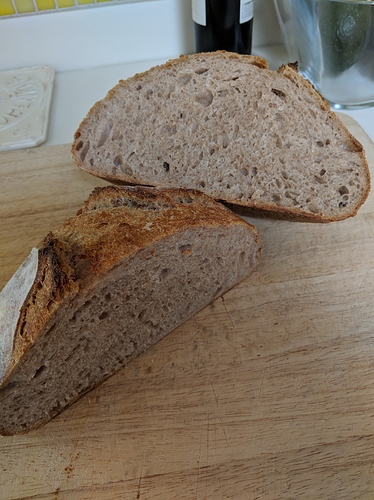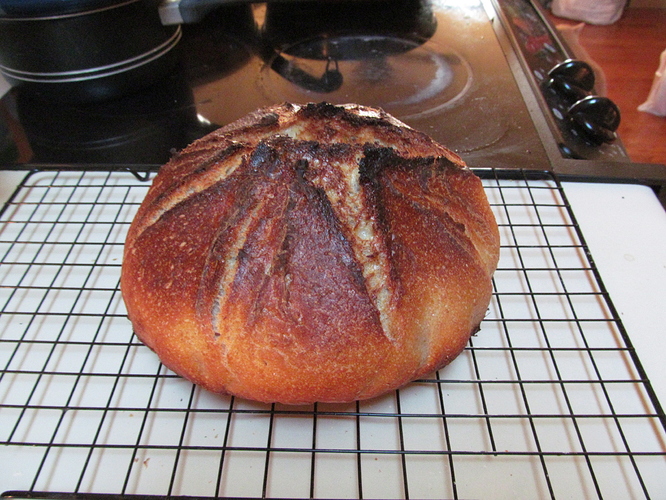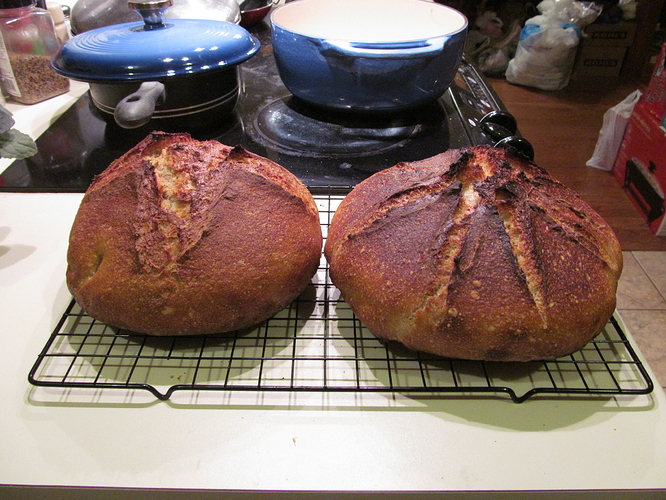Any comment on the bulk rise being done in the fridge?
Why not try it that way and see what happens? You could let us know.
Yes, the dough went directly from the refrigerator to the oven.
Ambient temperature can affect sourness and such, but mostly I see it as a tool for impacting timing. (Keep in mind there is also dough temp from warmer or colder water and refrigerated flour or fresh milled flour.)
In dealing with the intersection of life and dough, I raise the ambient/room temp when I’m in a rush (oven with light on) and I lower the temp when I want to slow things down (basement or refrigerator).
Here is a thread that discusses bulk rise in the fridge
My hunch…or perhaps I read this somewhere…is that a slow colder fermentation can “make up for” a lack of active gluten development via kneading/stretching and folding.
As I mentioned to Wendy above, though, I like to stretch and fold cold long ferments – when the dough is still small/flat – because the top of the dough starts to look a little dry/funny after 12+ hours, and if I’m bringing it up to room temp, after about an hour, I want what I at least imagine to be the warmer outside to get folded into the still-cold inside.
I meant “internal”, LOL! The internal temperature of the dough when it is cooked enough.

205F or higher
I did a bulk initial ferment for 3 days in the fridge and liked the results. The recipe was 50/50 whole wheat/white seeded bread recipe. It had a nice faint sourness about it.
For the next one, I will try Melissa’s no-knead method and then do second, final rise in the fridge overnight. Will do direct from fridge to oven.
Thanks for the feedback!!
Thank you!
Melissa…I cannot thank you enough for this wonderful experiment. I have been bumbling along here trying to make sourdough bread with my home made pineapple juice starter as well as Breadtopia’s dried starter. I ordered a new live starter along with Breadtopia’s white organic bread flour and followed your instructions to the letter.
The result is so wonderful that I cannot believe it has finally happened! You made the process so simple that we can do this despite our schedules.
You have given us a wonderful gift! Often we send these loaves to neighbors along with homemade soup if they are under the weather. Thank you!
Happy in CT
Peg,
I’m so glad to hear of your great experience following this recipe. Congratulations on your bread! Lucky neighbors 
I too found this article of great interest, however, was not so keen on the conclusion, that being said based on my experience, education, and knowledge; I was rather perplexed to say the least. I go to great lengths to acquire the ‘best bang for the buck’ ingredients, flours from https://k2milling.com/, filtered water using https://www.zerowater.com/,pink Himalayan salt, and then as best to my knowledge and understanding, apply myself. So when I found out that “the general look and flavor of the breads were similar” to not touched vs. something taken hours of stretching and folding, never mind 24 or more hours retarded in the fridge, I was rather perplexed to say the least.
I start my process Wednesday night, making a preferment with a sourdough starter that I made, and then about twelve hours later on Thursday take about four hours to make dough, stretching and folding, and then divide and place in a banneton and store in cold fridge, around 3-4°c until Saturday morning, and begin baking at 6:00am, straight from fridge to a cast iron pot. Depending on recipe, I can wait before baking, but so far so good. I bake just over a dozen loaves weekly of just sourdough using the above method. Maybe my method is beyond the pale so to speak, but unless the person eating my bread likes ‘Wonder bread’, they tend to speak highly of what I’ve made.
And the of course like so many, I’m rather found of Chad Robertson of Tartine and Zachary Golper of Bien Cuit, and have used their recipes and methodology. I love Zachary Golper recipes and methodology, every recipe I have followed, and I’ve made many of his recipes, always turn out perfect. Generally, when following a recipe, you must ‘tweak’ a little here and there, not with Zachary’s recipes, perfect every time. I sent him a link to this article, not because I was unsure, for I am not, however, I wanted to see what his opinion would be of this article, and here is his opinion:
“Thank you for the kind words. I took a minute to read the article and attached recipes from the Breadtopia article you sent me, and am happy to share with you my thoughts.
Firstly, while the premise of the experiment was an interesting topic worthy of debate under some circumstances, I was not very impressed with the rigidity of the experiment in general. The controls were not consistent, and the experiment was only done once, then repeated with an entirely different flour. Additionally, the author seemed to not have a very solid understanding of the purpose behind autolyse and “stretch and fold”.
I believe it was Raymond Calvel who named this process and was the first to implement it into his baking as a method tied into his production for SOME of his breads. It was intended for any dough using all bolted flour that was to be shaped in a long loaf, like a bâtard or baguette, as a means to use the enzymes naturally found in the wheat flour to break down the proteins just enough to allow for more extensibility in the dough. So the idea was, in essence, that if your dough was coming out too elastic, due to high protein, low fiber flour, try an autolyse, as it will increase extensibility (or ability to stretch the dough quickly without it bouncing back and “shrinking”) this naturally will limit your oven spring, due to the same principles that allow for extensibility in the shaping process. Now, utilizing slow fermentation will release even more of the same enzymes slowly over the course of the many hours a dough ferments. Autolyse plus slow fermentation is, in my opinion, both redundant and in the case that the shape is that of a boule, pointless.
“Stretch and fold” is a method that has profound effects for doughs made of gluten containing grains, by enhancing the strength of the dough sixfold every time you do it. The time between the folds allows the dough to relax, and for enzymes to work at the complex carbohydrates, converting them into simpler sugars which are then easy for yeast and bacteria to consume as food. As this happens, tightly wound protein strands are released from their coils. Through the friction of and tension created during “stretch and fold”, the proteins then can bind together, forming a gluten web, and thus structure is prepared for retaining gas during fermentation. “Stretch and fold” benefits your oven spring.
I say all this to break down the reason that autolyse plus “stretch and fold” are rather contradictory actions, that only have a reasonable place in baking when making a baguette.
You don’t make baguettes in cast iron dutch ovens. You make boules.
So if you’re making a whole grain bread and you are pre-soaking your flour in order to fully hydrate the bran and soften it so that it’s fiber minimally damaged gluten structure, then that is no longer in the category of “Autolyse”. That’s called “pre soaking”.
No-knead is just no-knead. Ethiopians and Eritreans have been doing it for thousands of years. Nothing new here. But it does make bread-making easy. (Thank you Jim Lahey!! You changed the world with your book!)
My opinion is that no-knead is for the person that wants bread to be simple and good. Hand kneading and folding and slow fermentation in conjunction are for those who want a better textured loaf, enhanced digestibility and an intimate relationship with the food they make and share (or sell).
I’m not sure if I’ve answered the question you had, but these are my thoughts on the article nonetheless.
Now, if the author were to somehow get wind of my comments, I would hope to pass on my gratitude for their curiosity and willingness to share what they learn. I would also hope that they would in the future, perform many tests (at least 8, keeping all controls as unchanging and consistent between the two doughs.
I wish you wellness and happy baking.
All the best,
Zachary”
So I happily continue to follow my long drawn out process of producing bread, with a ton of flavour, deep dark crust, which takes a few days to become stale.
Thank you for sharing the blog post with Zachary Golper. I appreciate your and his interest in the experiment. I’m curious to learn more about the idea that the autolyse and the stretch and fold are contradictory actions, as this is accepted method by many professional bakers, including Chad Robertson, whom you mention.
My hope with this experiment is that other home and professional bakers will see the results as intriguing, give the experiment a go themselves, and report on their results.
It only takes 12-24 hours, and you are rewarded with bread to eat at the end, so it’s win-win. Food and knowledge.
As I understand, the whole purpose to autolyze is to reduce the time spent kneading, a.k.a. stretching and folding, adding salt prevents the doughs ability to stretch. But at the same time adds strength, flavour, makes the dough elastic which increases strength and time to knead by hand or machine. So adding salt to dough, and the salt is required, this action is not unlike a contradiction. Hope that makes some sense?
I do a short autolyze, meanwhile I add the salt to some water, around 100g of water, and mix well, dissolving some of the salt, which I add just before my second stretch and fold, and continue stretching and folding, each time I stretch and fold, the dough is easier to manipulate after adding salt.
It seems to me that we humans are constantly making up stories (theories) to explain complex phenomena that we observe and don’t really understand. Sourdough bread baking definitely qualifies as a complex phenomenon.
As a trained scientist, my story (theory) about science is that science is a process for finding ways that work. A lot of people (including a lot of scientists) have a different story about science which is that it is a process for finding The Truth™. I personally don’t agree with that story (If anyone’s interested in pursuing the either/or’s of these competing stories about what science is and does, there is a whole literature about it. I’d recommend starting with Sir Karl Popper.)
Anyway, there are a lot of totally different, and in my view, equally successful ways of baking bread. Equally successful in the sense that what you end up with is a healthy, delicious, nutritious miracle of derived tall grass. I’ve baked a lot of loaves of bread, using a lot of different techniques. For me, some work better than others, and as a result, I’ve developed a bunch of my own stories about why that is. But I don’t think that negates anyone else’s stories and techniques. Baking bread is a wide and wondrous journey; there are just a lot of right ways to do it.
Of course there are even more wrong ways to do it; and that’s what makes it a never-ending challenge.
The no-knead came out really well - seemed like a denser crumb than with the stretching/folding. Final rise was 8 hours in fridge - need to cut the bread better.
Thank you for sharing your bread pics and results! Looks delicious!
Thank you for the sharing your experiment results. Until I tried your no knead method, my high hydration attempts have been quite frustrating to say the least. After changing a couple weights for the flour I was using, i made a loaf using the no knead method. I found it to be much easier than other methods I have tried and the bread had a better taste and a good crumb.
Congratulations! I’m glad I could help you find a method and formula that works for you. It’s definitely helpful to see the different ways people arrive at delicious bread 
New experiment, store flour vs milled flour for the bread flour in the loafs.
The store flour loaf. The milled flour on the left side. All things being equal, I would say the one on the left (milled flour) won. Good oven spring, it held it shape better but took longer to bake (9 minutes). I think more hydration is needed because you can’t sift all the bran out of the flour and bran acts like a sponge to the water. The crumb test comes in the morning. I expect the store flour loaf will have bigger holes do to it’s being more elastic. Both were made in my Kitchen Aid mixer and baked in a cast iron Dutch oven. This is how much extra flour I had. LOL



